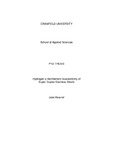JavaScript is disabled for your browser. Some features of this site may not work without it.
| dc.contributor.advisor | Robinson, M. J. | |
| dc.contributor.author | Alsarraf, Jalal | |
| dc.date.accessioned | 2010-09-22T08:51:06Z | |
| dc.date.available | 2010-09-22T08:51:06Z | |
| dc.date.issued | 2010-04 | |
| dc.identifier.uri | http://dspace.lib.cranfield.ac.uk/handle/1826/4562 | |
| dc.description.abstract | This thesis describes the metallurgical and environmental factors that influence hydrogen embrittlement of super duplex stainless steels and presents a model to predict the rate at which embrittlement occurs. Super duplex stainless steel has an austenite and ferrite microstructure with an average fraction of each phase of approximately 50%. An investigation was carried out on the metallurgical and environmental factors that influence hydrogen embrittlement of super duplex stainless steels. Tensile specimens of super duplex stainless steel were pre-charged with hydrogen for two weeks in 3.5% NaCl solution at 50º C at a range of applied potentials to simulate the conditions that exist when subsea oilfield components are cathodically protected in seawater. The pre-charged specimens were then tested in a slow strain rate tensile test and their susceptibility to hydrogen embrittlement was assessed by the failure time, reduction in cross-sectional area and examination of the fracture surface. The ferrite and austenite in the duplex microstructures were identified by analysing their Cr, Ni, Mo and N contents in an electron microscope, as these elements partition in different concentrations in the two phases. It was shown that hydrogen embrittlement occurred in the ferrite phase, whereas the austenite failed in a ductile manner. An embrittled region existed around the circumference of each fracture surface and the depth of this embrittlement depended on the hydrogen charging time and the potential at which the charging had been carried out. The depth of embrittlement was shown to correlate with the rate of hydrogen diffusion in the alloy, which was measured electrochemically using hydrogen permeation and galvanostatic methods. A two-dimensional diffusion model was used to calculate the hydrogen distribution profiles for each experimental condition and the model could be employed to provide predictions of expected failure times in stressed engineering components. | en_UK |
| dc.language.iso | en | en_UK |
| dc.publisher | Cranfield University | en_UK |
| dc.rights | © Cranfield University 2010. All rights reserved. No part of this publication may be reproduced without the written permission of the copyright owner. | en_UK |
| dc.subject | Ferritic-austenitic stainless steel | en_UK |
| dc.subject | Hydrogen permeation | en_UK |
| dc.subject | Diffusion | en_UK |
| dc.subject | Hydrogen uptake | en_UK |
| dc.subject | Cathodic protection | en_UK |
| dc.subject | Cracking | en_UK |
| dc.subject | Galvanostatic | en_UK |
| dc.subject | Modelling | en_UK |
| dc.subject | Austenite spacing | en_UK |
| dc.title | Hydrogen Embrittlement Susceptibility of Super Duplex Stainless Steels | en_UK |
| dc.type | Thesis or dissertation | en_UK |
| dc.type.qualificationlevel | Doctoral | en_UK |
| dc.type.qualificationname | PhD | en_UK |
